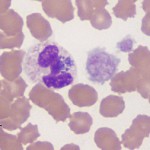Photomicrographs of a venous blood sample from a dog
Case information
A 4-year-old spayed female Siberian Husky presented after a five-day history of inappetence and lethargy. Two days prior to presentation, the dog had vomited parts of a squeaky toy and a corn cob and became anorexic. Additionally, the dog had two episodes of diarrhea the day before presentation. Her owners resided in Tompkins County, NY and they had not travelled with the dog. On presentation, the husky was febrile with a temperature of 105°F. No abnormalities were identified on physical examination or abdominal and thoracic radiographs.. Digital rectal examination showed evidence of hematochezia (fresh blood in the stool). Blood was drawn for a 4Dx Plus SNAP test (Idexx Laboratories), which tests for the presence of antibodies to Ehrlichia canis/chaffeensis/ewingii, Anaplasma phagocytophilum/platys, and Borrelia burgdorferi, as well as for Dirofilaria immitis antigens; all were negative in this patient. Evaluate the abbreviated CBC results (Table 1) and blood smear images, then answer the questions below.
| Table 1: Abbreviated CBC results | |||
| Test | Results | Units | Ref Interval |
| Hct | 40 L | % | 41-60 |
| WBC | 4.0 L | thous/μl | 5.7-14.2 |
| Seg neut | 3.7 | thous/μl | 2.7-9.4 |
| Lymph | 0.2 L | thous/μl | 0.9-4.7 |
| Eosin | 0.0 L | thous/μl | 0.1-2.1 |
| PLT | 36* L | thous/μl | 186-545 |
| MCV | 19.2 H | thous/μl | 8.4-14.1 |
| *Platelet clumps observed in the smear; the provided count is considered a minimum count. | |||
- What are the differential diagnoses for the abnormality present in the observed white blood cells?
- Does your diagnosis explain any of the abnormalities present in the CBC and on physical examination?
 |
 |
Answer on next page
